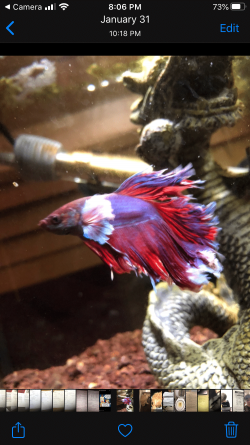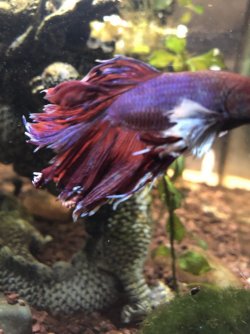I have noticed my betta's fins look different than they did a few months ago. I was thinking it might be fin rot, but I'm not fully sure. I have Melafix to cure with, but I want to make sure it has fin rot first. Can any of you confirm if this is fin rot or not? If so, am I taking the right steps to cure it? The first pic is from a few months ago, the second and third are now. Thanks.
You are using an out of date browser. It may not display this or other websites correctly.
You should upgrade or use an alternative browser.
You should upgrade or use an alternative browser.
Betts fin rot?
- Thread starter max22
- Start date
The April FOTM Contest Poll is open!

🏆 Click to vote! 🏆
I can't really tell because of the shape of the fins but fin rot is caused by poor water quality or a dirty tank that damages the fish's mucous layer and allows bad bacteria to attack the skin and fins.
The best treatment for fin rot (or suspected fin rot) is cleaning the tank up and adding salt. Quite often cleaning the tank will do the job without salt.
Wipe the inside of the glass down with a clean fish sponge.
Do a 75% water change and gravel clean the substrate every day for 2 weeks.
Make sure any new water is free of chlorine/ chloramine before it's added to the tank.
Clean the filter if it hasn't been done in the last 2 weeks. Wash filter media/ materials in a bucket of tank water and re-use the media. Tip the bucket of dirty water on the lawn/ garden.
Add some salt (see directions below).
------------------
SALT
You can add rock salt (often sold as aquarium salt) to the aquarium at the dose rate of 1 heaped tablespoon per 20 litres of water. If there is no improvement after 48 hours you can double that dose rate so there is 2 heaped tablespoons of salt per 20 litres.
If you only have livebearers (guppies, platies, swordtails, mollies), goldfish or rainbowfish in the tank you can double that dose rate, so you would add 2 heaped tablespoons per 20 litres and if there is no improvement after 48 hours, then increase it so there is a total of 4 heaped tablespoons of salt per 20 litres.
Keep the salt level like this for at least 2 weeks but no longer than 4 weeks otherwise kidney damage can occur. Kidney damage is more likely to occur in fish from soft water (tetras, Corydoras, angelfish, gouramis, loaches) that are exposed to high levels of salt for an extended period of time, and is not an issue with livebearers, rainbowfish or other salt tolerant species.
The salt will not affect the beneficial filter bacteria but the higher dose rate (4 heaped tablespoons per 20 litres) will affect some plants and some snails. The lower dose rate will not affect plants, shrimp or snails.
After you use salt and the fish have recovered, you do a 10% water change each day for a week using only fresh water that has been dechlorinated. Then do a 20% water change each day for a week. Then you can do bigger water changes after that. This dilutes the salt out of the tank slowly so it doesn't harm the fish.
If you do water changes while using salt, you need to treat the new water with salt before adding it to the tank. This will keep the salt level stable in the tank and minimise stress on the fish.
The best treatment for fin rot (or suspected fin rot) is cleaning the tank up and adding salt. Quite often cleaning the tank will do the job without salt.
Wipe the inside of the glass down with a clean fish sponge.
Do a 75% water change and gravel clean the substrate every day for 2 weeks.
Make sure any new water is free of chlorine/ chloramine before it's added to the tank.
Clean the filter if it hasn't been done in the last 2 weeks. Wash filter media/ materials in a bucket of tank water and re-use the media. Tip the bucket of dirty water on the lawn/ garden.
Add some salt (see directions below).
------------------
SALT
You can add rock salt (often sold as aquarium salt) to the aquarium at the dose rate of 1 heaped tablespoon per 20 litres of water. If there is no improvement after 48 hours you can double that dose rate so there is 2 heaped tablespoons of salt per 20 litres.
If you only have livebearers (guppies, platies, swordtails, mollies), goldfish or rainbowfish in the tank you can double that dose rate, so you would add 2 heaped tablespoons per 20 litres and if there is no improvement after 48 hours, then increase it so there is a total of 4 heaped tablespoons of salt per 20 litres.
Keep the salt level like this for at least 2 weeks but no longer than 4 weeks otherwise kidney damage can occur. Kidney damage is more likely to occur in fish from soft water (tetras, Corydoras, angelfish, gouramis, loaches) that are exposed to high levels of salt for an extended period of time, and is not an issue with livebearers, rainbowfish or other salt tolerant species.
The salt will not affect the beneficial filter bacteria but the higher dose rate (4 heaped tablespoons per 20 litres) will affect some plants and some snails. The lower dose rate will not affect plants, shrimp or snails.
After you use salt and the fish have recovered, you do a 10% water change each day for a week using only fresh water that has been dechlorinated. Then do a 20% water change each day for a week. Then you can do bigger water changes after that. This dilutes the salt out of the tank slowly so it doesn't harm the fish.
If you do water changes while using salt, you need to treat the new water with salt before adding it to the tank. This will keep the salt level stable in the tank and minimise stress on the fish.
Why do we seem to get so many bettas with fine rot on this site.I can't really tell because of the shape of the fins but fin rot is caused by poor water quality or a dirty tank that damages the fish's mucous layer and allows bad bacteria to attack the skin and fins.
The best treatment for fin rot (or suspected fin rot) is cleaning the tank up and adding salt. Quite often cleaning the tank will do the job without salt.
Wipe the inside of the glass down with a clean fish sponge.
Do a 75% water change and gravel clean the substrate every day for 2 weeks.
Make sure any new water is free of chlorine/ chloramine before it's added to the tank.
Clean the filter if it hasn't been done in the last 2 weeks. Wash filter media/ materials in a bucket of tank water and re-use the media. Tip the bucket of dirty water on the lawn/ garden.
Add some salt (see directions below).
------------------
SALT
You can add rock salt (often sold as aquarium salt) to the aquarium at the dose rate of 1 heaped tablespoon per 20 litres of water. If there is no improvement after 48 hours you can double that dose rate so there is 2 heaped tablespoons of salt per 20 litres.
If you only have livebearers (guppies, platies, swordtails, mollies), goldfish or rainbowfish in the tank you can double that dose rate, so you would add 2 heaped tablespoons per 20 litres and if there is no improvement after 48 hours, then increase it so there is a total of 4 heaped tablespoons of salt per 20 litres.
Keep the salt level like this for at least 2 weeks but no longer than 4 weeks otherwise kidney damage can occur. Kidney damage is more likely to occur in fish from soft water (tetras, Corydoras, angelfish, gouramis, loaches) that are exposed to high levels of salt for an extended period of time, and is not an issue with livebearers, rainbowfish or other salt tolerant species.
The salt will not affect the beneficial filter bacteria but the higher dose rate (4 heaped tablespoons per 20 litres) will affect some plants and some snails. The lower dose rate will not affect plants, shrimp or snails.
After you use salt and the fish have recovered, you do a 10% water change each day for a week using only fresh water that has been dechlorinated. Then do a 20% water change each day for a week. Then you can do bigger water changes after that. This dilutes the salt out of the tank slowly so it doesn't harm the fish.
If you do water changes while using salt, you need to treat the new water with salt before adding it to the tank. This will keep the salt level stable in the tank and minimise stress on the fish.
Poor quality fish caused by inbreeding.Why do we seem to get so many bettas with fine rot on this site.
Fish coming from the same breeders in Asia.
Fish coming through the same importers in each country.
Drug resistant bacteria caused by too many people mis-using anti-biotics and other types of fish medications.
Most reactions
-
 324
324 -
 202
202 -
 185
185 -
 148
148 -
 139
139 -
W
135
-
 127
127 -
 125
125 -
 122
122 -
 119
119 -
 93
93 -
 73
73 -
 69
69 -
 66
66 -
 64
64
Latest Discussions
- Replies
- 6
- Views
- 57
trending
-
-
-
-
-
F-1 Angel... a bit nervous... it'll be my 1st F-1 fish...
- Started by Magnum Man
- Replies: 17
Members online
Total: 538 (members: 8, guests: 530)





